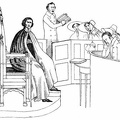7/10
The bagpipe appears to have been from time immemorial a special favourite instrument with the Celtic races; but it was perhaps quite as much admired by the Slavonic nations. In Poland, and in the Ukraine, it used to be made of the whole skin of the goat in which the shape of the animal, whenever the bagpipe was expanded with air, appeared fully retained, exhibiting even the head with the horns; hence the bagpipe was called kosa, which signifies a goat. The woodcut represents a Scotch bagpipe of the eighteenth century.
- Author
- Musical Instruments
Written by Carl Engel
Published in 1875
Available from gutenberg.org - Posted on
- Thursday 30 July 2020
- Dimensions
- 308*750
- Albums
- Visits
- 1113
- Downloads
- 41
 Download Photo
Download Photo





